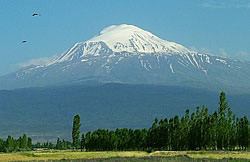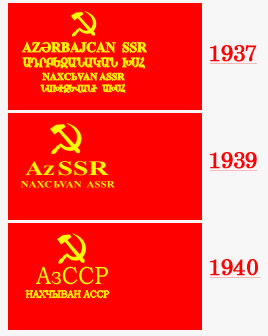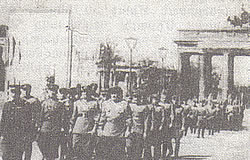USSR (part 1)
New losses
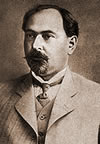 Nariman Narimanov On December 1, 1920 as the news about the Sovietization of Armenia reached Azerbaijan, Narimanov, the chief of the Revolutionary Committee of Azerbaijan, surprisingly declared about the cessation of the Azerbaijan’s claims to the Armenian territories and proclaimed Karabakh, Nakhichevan and Zanguezour, integral parts of Armenia. However, just a day later, the Narimanov’s decree appeared in a slightly different wording: Nakhichevan and Zanguezour were recognized parts of Armenia, whereas Karabakh was given the right of self-determination.
Nariman Narimanov On December 1, 1920 as the news about the Sovietization of Armenia reached Azerbaijan, Narimanov, the chief of the Revolutionary Committee of Azerbaijan, surprisingly declared about the cessation of the Azerbaijan’s claims to the Armenian territories and proclaimed Karabakh, Nakhichevan and Zanguezour, integral parts of Armenia. However, just a day later, the Narimanov’s decree appeared in a slightly different wording: Nakhichevan and Zanguezour were recognized parts of Armenia, whereas Karabakh was given the right of self-determination.
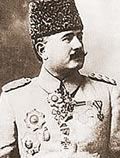 General Kazim Karabekir was the signatory from the Turkish side in the Treaty of Alexandropol and in the Treaty of Kars.Nonetheless, the strange alliance between the Turks and the Russian Bolsheviks played a fatal role in the final determination of borders. The Treaty of Alexandropol, signed in December of 1920 asserted the defeat of Armenia. Then in March of 1921, Turkey and Russia signed a mysterious Treaty of Moscow to tear Nakhichevan away from Armenia and to attach it to the Soviet Azerbaijan.
General Kazim Karabekir was the signatory from the Turkish side in the Treaty of Alexandropol and in the Treaty of Kars.Nonetheless, the strange alliance between the Turks and the Russian Bolsheviks played a fatal role in the final determination of borders. The Treaty of Alexandropol, signed in December of 1920 asserted the defeat of Armenia. Then in March of 1921, Turkey and Russia signed a mysterious Treaty of Moscow to tear Nakhichevan away from Armenia and to attach it to the Soviet Azerbaijan.
In summer of 1921, the Caucasian Office of the Communist Party of Bolsheviks held a number of sessions to solve the Karabakh problem. On July 4, the plenary session issued a decree confirming the belonging of Karabakh to Armenia. However, on the next day, Stalin convened an extraordinary session to transfer Karabakh to Azerbaijan. The Treaty of Kars signed in October of 1921 completed the carve-up of Armenia.
As a result of the Soviet and Turkish manipulations, the territory of the Soviet Republic of Armenia was reduced to 30,000 square km. Armenia was even deprived of Mount Ararat, its main symbol.
Fate of Nakhichevan
 Old Armenian cemetery near Julfa, Nachichevan, now destroyed.During the Soviet rule, Nakhichevan, the Armenian province with the Armenian name and the unique Armenian historical and cultural heritage underwent an unprecedented period of “white genocide” and “ethnic cleansing”. Predominant there in the 19th century, the Armenians composed 50% of the population in the 20s of the 20th century.
Old Armenian cemetery near Julfa, Nachichevan, now destroyed.During the Soviet rule, Nakhichevan, the Armenian province with the Armenian name and the unique Armenian historical and cultural heritage underwent an unprecedented period of “white genocide” and “ethnic cleansing”. Predominant there in the 19th century, the Armenians composed 50% of the population in the 20s of the 20th century.
From 1936, when the Turks of Azerbaijan became “Azerbaijanis” instead of “Caucasian Tartars”, the Soviet historians followed the instructions of the Communist Party leaders and began creating the so-called “history of Azerbaijan”. In order to erase any trace of the region’s Armenian past, many unique Armenian monuments were destroyed, including khachkars and churches of early Christian period. The land was then extensively peopled with the Turks while the Armenians left on a large scale. According to the census of 1959, the number of Armenians in the region decreased to 1, 5%!
Stalin’s purges
 Joseph Stalin From 1922 to 1936, Armenia formed part of the Transcaucasian Soviet Federal Socialist Republic, consisting of Armenia, Georgia and Azerbaijan. The new Constitution of the USSR adopted in 1936 dissolved the Transcaucasian Republic. Armenia became one of 15 Soviet Socialist Republics. Like the other Republics, Armenia was governed by the Central Committee of the Republican Communist Party. The 1st Secretaries of the Party were appointed from Moscow.
Joseph Stalin From 1922 to 1936, Armenia formed part of the Transcaucasian Soviet Federal Socialist Republic, consisting of Armenia, Georgia and Azerbaijan. The new Constitution of the USSR adopted in 1936 dissolved the Transcaucasian Republic. Armenia became one of 15 Soviet Socialist Republics. Like the other Republics, Armenia was governed by the Central Committee of the Republican Communist Party. The 1st Secretaries of the Party were appointed from Moscow.
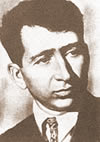 Great Armenian poet Eghishe Charents was arrested and executed during Stalin’s purges.
Great Armenian poet Eghishe Charents was arrested and executed during Stalin’s purges.
From the mid 30s, just like the other peoples of the Soviet Union, Armenians suffered from a large-scale campaign of political terror launched by Joseph Stalin. The purges touched virtually every Armenian family. Thousands of writers, artists, scientists and political leaders were executed or exiled.
The WWII
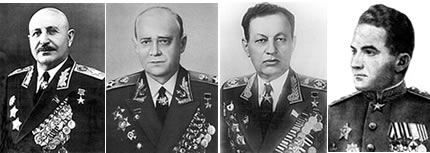 The Armenian Marshals: Hovannes Bagramyan, Marshal of the Soviet Union; Ivan Isakov, Admiral of the Fleet; Hamazasp Babadzhanian, Chief Marshal of the Mechanized Forces; and Sergei Khudyakov (born Armenak Khanferiants), chief Marshal of the Air Force.During the World War II, Armenians made an important contribution to the Soviet victory. Over 500 thousand of Armenians fought for the Soviet army, and half of them fell in battles. 106 Armenians were decorated as Hero of the Soviet Union.
The Armenian Marshals: Hovannes Bagramyan, Marshal of the Soviet Union; Ivan Isakov, Admiral of the Fleet; Hamazasp Babadzhanian, Chief Marshal of the Mechanized Forces; and Sergei Khudyakov (born Armenak Khanferiants), chief Marshal of the Air Force.During the World War II, Armenians made an important contribution to the Soviet victory. Over 500 thousand of Armenians fought for the Soviet army, and half of them fell in battles. 106 Armenians were decorated as Hero of the Soviet Union.
 Armenian pilot Nelson Stepanyan was decorated as Hero of the Soviet Union twice.
Armenian pilot Nelson Stepanyan was decorated as Hero of the Soviet Union twice.
5 Armenian infantry divisions were formed. The 89th Rifle Division (Tamanian division) was especially famous, and fought in numerous battles during the war. Armenia gave 4 marshals and 60 generals. The Armenian Church and the Armenian colonies abroad donated large sums of money.
After the WW II, the Armenian and Georgian Republics laid territorial claims to Turkey. However, the Soviet Government was not willing to return the Armenian lands, and shortly thereafter stated that the USSR has no claims to Turkey.


